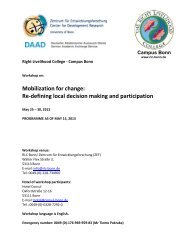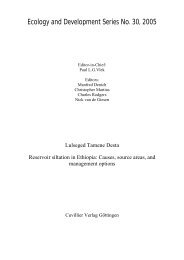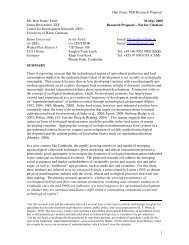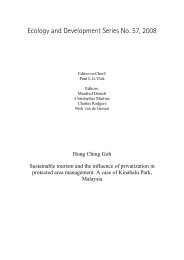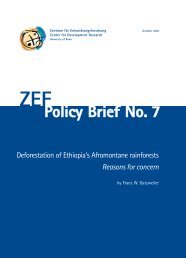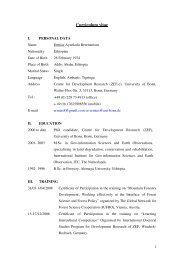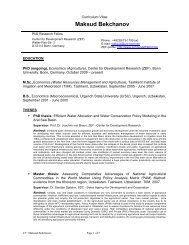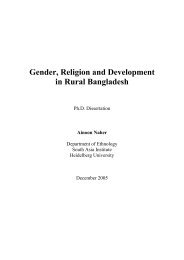Ecology and Development Series No. 10, 2003 - ZEF
Ecology and Development Series No. 10, 2003 - ZEF
Ecology and Development Series No. 10, 2003 - ZEF
- No tags were found...
You also want an ePaper? Increase the reach of your titles
YUMPU automatically turns print PDFs into web optimized ePapers that Google loves.
Impacts of human use on the forest vegetation5.3.3 Population structure of treesThe comparative patterns of the population structure of the tree species recorded in thefive forest categories are presented in Table 5.7. Besides, the population structure ofthree selected tree species is shown in Figure 5.3. These three species were chosen sincetheir population structures represent three different regeneration behaviors with respectto the different forest categories.Some tree species, which regenerate profoundly under natural forestconditions, seem to fail under the managed forest condition. Examples of such speciesare Elaeodendron buchananii, Mimusops kummel, <strong>and</strong> Olea capensis ssp. hochstetteri(Table 5.7). For some tree species, regeneration (seedling population) decreased in themanaged forest categories. For example, Diospyros abyssinica has less seedlingpopulations in the managed forests (SEMIFOR-NEW, SEMIFOR-OLD <strong>and</strong> SEMIFOR-PLAN) than in the undisturbed forests (NATFOR <strong>and</strong> SECFOR; see Table 5.7). Threegroups of plant species can be recognized based on their population structure in thedifferent forest categories:(a) Type I: Tree species in this group have a high number of seedlings, withdecreasing number of stems toward the higher height classes. Hence, the distribution ofthe population structure resembles an inverted J-shape in all forest categories. Examplesof this group are Albizia gr<strong>and</strong>ibracteata <strong>and</strong> Sapium ellipticum (Figure 5.3; Table 5.7).(b) Type II. Tree species in this group have no or few seedling populations inundisturbed forests, <strong>and</strong> have a higher number of seedling populations in the managedforests. Examples for these are Millettia ferruginea <strong>and</strong> Cordia africana (Figure 5.3;Table 5.7). However, the number of mature stems of Cordia decreased in managedforests compared to the undisturbed forests, <strong>and</strong> finally disappeared from theSEMIFOR-PLAN.(c) Type III: The tree species in this category have no individuals in themanaged forest. Examples: Bridelia micrantha, Galiniera saxifraga, <strong>and</strong> Veprisdainelli.85



